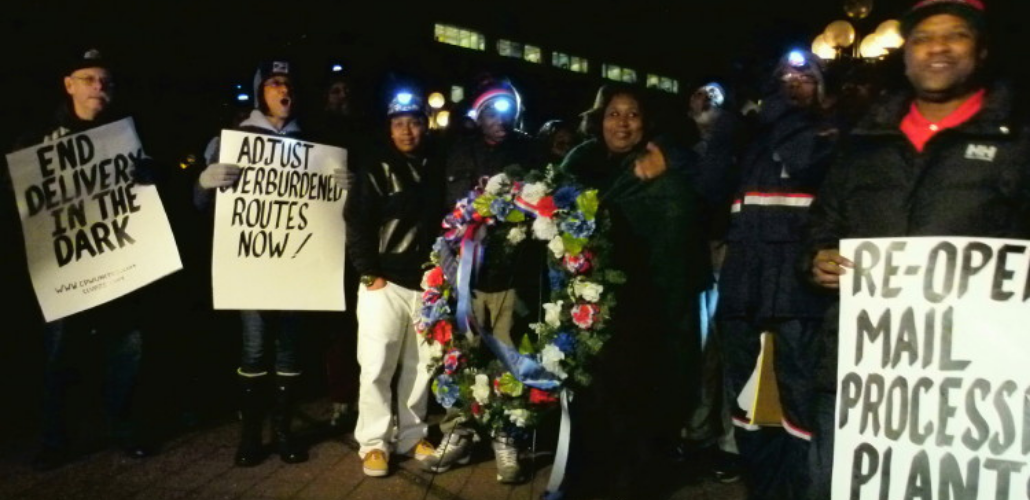Letter Carriers Resist After-Dark Delivery

Letter carriers rallied in 2014 against delivery in the dark after the on-the-job death of a Maryland carrier, Tyson Barnett. The same problems persist today. Photo: Joe Piette
Once upon a time, a nip in the air and the crunch of leaves underfoot meant peak season for shipping—an annual onslaught of catalogs and Christmas cards and online shopping. Those were the old days; since Covid hit, peak season never stops.
But the holiday rush and dwindling daylight can only intensify the crisis of understaffing and overwork at the Postal Service, where speedup and harassment are management’s go-to when it can’t or won’t hire enough people to get the job done. Letter carriers—who are being hounded to deliver the mail long after sunset, day after shorter day after shorter day—are starting to resist.
Letter Carriers (NALC) in Chicago held a public protest in September against late start times and after-dark delivery. Branch 11 President Mack Julion said the union won’t go along with giving out flashlights to new carriers on his watch. Delivery after dark is dangerous—and not just in high-crime neighborhoods. “Try doing anything in the dark,” he said. “Try cutting the grass. Yeah, you maybe can get it done, but it’s a whole hell of a lot easier when the sun is out, isn’t it?”
Besides, Julion said, it’s worse service: “Say it wasn’t dangerous. Do you want your mail delivered to you at 9 o’clock at night?”
Chicago carriers are so understaffed that every day about 100 routes go partially or completely undelivered. Management denies this, so the union started tallying the data to prove it. Stewards in every post office send daily reports to the branch headquarters, where a spreadsheet is compiled. (Notice this activity has stewards involving members in union action on a top concern; see our latest Steward’s Corner, “How to Think Like an Organizer.”)
Julion shares the data routinely with Congressmembers; that plus the action prompted an October 15 Congressional hearing on the problem.
JUST SAID NO
It’s not just Chicago. “There’s more hours than anyone wants, and more days,” said Dave Staiger, a rural carrier in Kalamazoo. “For example, I’m on day eight in a row of at least 11 right now, including Saturdays and Sundays.
“Really Amazon has been dictating the pace. Sundays they call ‘Amazon Sundays’—when we go in, that’s all we’re delivering.”
Rural delivery, done from a vehicle, poses its own hazards in the dark. A postal truck pulled over at a roadside mailbox may be struck by a car; a customer who isn’t expecting you in the driveway may mistake you for a prowler. And then there’s the danger of driving fatigued.

SUPPORT LABOR NOTES
BECOME A MONTHLY DONOR
Give $10 a month or more and get our "Fight the Boss, Build the Union" T-shirt.
On a few occasions, Staiger and his co-workers have pushed back against the long hours with collective action. Once everyone individually filled out the form to register a safety hazard. Recently, buoyed by an agreement between the Rural Carriers and management that delivery after 8 p.m. should be avoided, four out of five carriers declined to take a last round of packages out at that hour. “And we didn’t face any discipline,” Staiger said. “The postmaster did ask to see the statement from the union, and pointed out it doesn’t say ‘never,’ it just says ‘try to avoid.’”
‘IT’S A CATCH-22’
In Seattle, NALC Branch 79 Sergeant-at-Arms Virgilio Goze said the contractual hours limits for city carriers—12 hours a day if you’re on the overtime list, and 60 hours a week—are routinely violated, and grieved by the union. In his post office alone, the penalty paychecks total thousands of dollars every week. “But it’s not much of a deterrent,” he said. Management treats it as “just the cost of doing business.”
There’s even less protection for the bottom tier, City Carrier Assistants (each of the four postal unions has a similar category), who can be made to work seven days a week. “They treat them like dirt,” Goze said. “It’s a Catch-22. We want to hire, but those people we do hire get worked to the ground, and they quit.”
As a shop steward, Goze feels he’s running out of options. Through group action and grievances, he and his co-workers have established protection from discipline when they individually refuse to work past 12 hours due to pain and exhaustion. But the post office is so short-staffed that exercising this right means the mail will sit undelivered overnight. Like many postal workers, Goze takes pride in getting the mail out. “Some of us barely see our families, but we have to provide a service to the American people,” he said.
TWO-TIER IS THE PROBLEM
Even where management is trying earnestly to hire, it’s struggling. To staff up, the wages would have to improve—especially for the bottom tier.
NALC settled a contract this year that made no dent in two-tier. A rank-and-file caucus in Portland, Oregon, campaigned for a “no” vote, but with no organized national opposition, the deal passed overwhelmingly. The Rural Carriers’ contract expired in May; the union and management agreed to extend negotiations, and apparently they’re still at it.
Neither national union invited members to participate in any kind of contract campaign.
Entry-level postal carriers make much less than entry-level UPS drivers—yet the prospects for abolishing the lower tier look brighter at UPS, where members rejected the latest contract over this issue but union leaders imposed it anyway. Sean O’Brien, who stands a strong chance of winning the Teamsters presidency in November, has promised to make it a strike issue in the next contract.
UPS drivers are also resisting forced overtime. Read more.






